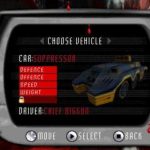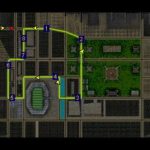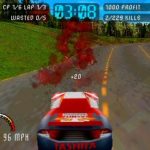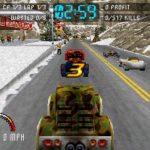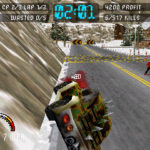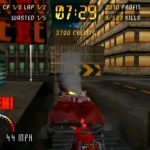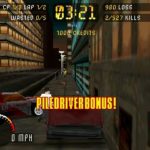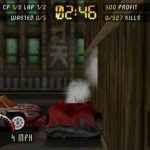2005 SCi / Stainless Games
Platform: Gizmondo
This is a smaller piece intended for inclusion in The Games That Weren’t book that didn’t make the final cut. Within the book is an in-depth and detailed 18 page story about the unreleased Carmageddon TV (CTV from this point on) by Visual Science. Often it has been stated that CTV was due for release on the Gizmondo hand-held, but this wasn’t the case at all. In fact, it was a conversion of the original PC classic.
We had planned to tell the story of the Gizmondo conversion in the book, but had to cut the piece due to space. As part of our Bonus material series, here is the full raw article for your enjoyment, where we speak to the Stainless Games team – Patrick Buckland, Ian Moody, Steven Haggerty, Neil (Nobby) Barnden, Kev Martin and Will McCourt. Special thanks to Justin Castle for allowing us to use his screenshots from the demo.
Please note that it hasn’t been professionally proof read compared to the published pieces in the book. Apologies for any errors, which we will be happy to fix over time.
Although Visual Science’s Carmageddon TV development had been faltering and eventually saw a professional relationship destroyed, elsewhere another was about to be repaired after half a decade towards mid-2005, when opportunity arose to develop for the new upcoming and exciting Gizmondo handheld. However, this was not the CTV conversion as often reported over the years online.
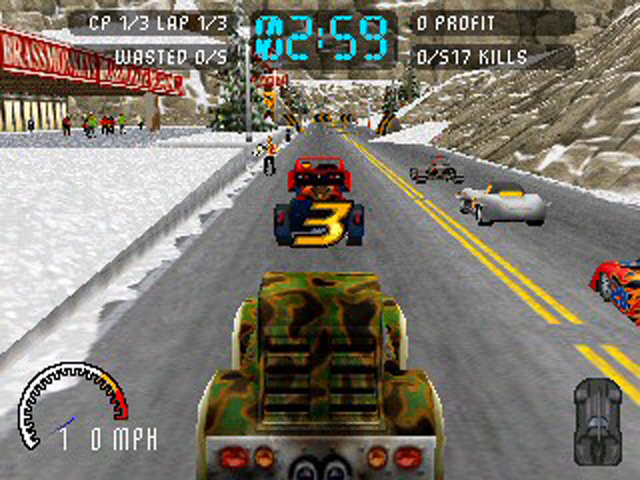
Stainless Games had been unceremoniously dropped from the Carmageddon franchise by SCi not long after completing the second game, after wanting a bit of a break before doing a 3rd title. So it was handed to Australian company Torus instead, surfacing in 2000 as the (in Patrick Buckland’s words) “dog’s testicle of a game” Carmageddon: TDR 2000. It seemed that after a while though, wounds had finally begun to heal.
“I’m a ‘life’s too short’ sort of person, so we arranged a conversion of Carmageddon 1 for SCi.” began Patrick. “It came about after seeing Nintendo release a remastered version of Zelda (Ocarina of time, I think) on new hardware. So I thought, ‘Why don’t we do the same thing with Carmageddon‘, and contacted SCi about it. They liked the idea, and it morphed into a multi-game deal they had arranged with Gizmondo. We were doing it as a sort of relationship repairing exercise, with the plan that it would restart things and lead to a new Carmageddon[1].”
With Patrick already busy developing a re-imagining of Crystal Quest for the Xbox 360, overseeing production was Matt Edmunds. Handling development was Lez Andrew, Kevin Martin, Ian Moody and lead developer Steve Haggerty. “I was responsible for packaging the whole thing up.” began Steve. “I think Kev did all the clever low level maths / physics stuff, Lez I think worked on front end and gameplay stuff. Ian I seem to remember doing a lot of pedestrian work.”
Development was carried out in Microsoft Visual C in combination with using a simple SDK provided with the hardware, with debugging and testing carried out through a simple USB cable connection to the Gizmondo. “Our development unit was almost the same as the retail Gizmondo, but with some restrictions removed.” recalled Kevin. “A lot of our development was done on PC, and the Gizmondo hardware was just used to check everything worked as expected.”
The original PC source code was used as a starting point, initially translating everything over to a Gizmondo friendly format. “My job was to convert the original game assets into a format that the Gizmondo could handle.” began Ian. “I remember there were no written specs for our game data format, so I ended up looking at the source code that read files in, worked out what was what, then wrote back out in a friendlier format. I also have hazy memories of converting the image and texture assets to DXT compressed format (basically the DirectX cheesy compression system) to get the sizes down.”
“The new car skins at higher resolution and painted in shading looked far better.”
Artwork was handled by both Neil “Nobby” Barnden and Will McCourt, who rather than just porting assets, also remastered and enhanced them. “Vehicle textures were recreated from multiple original maps to a single one at a higher resolution and greater colour depth. We baked in lighting, additional specular/reflection maps and some optimisations. Small improvements were also made to the vehicle models, remapped to support their new single material.” recalled Will.
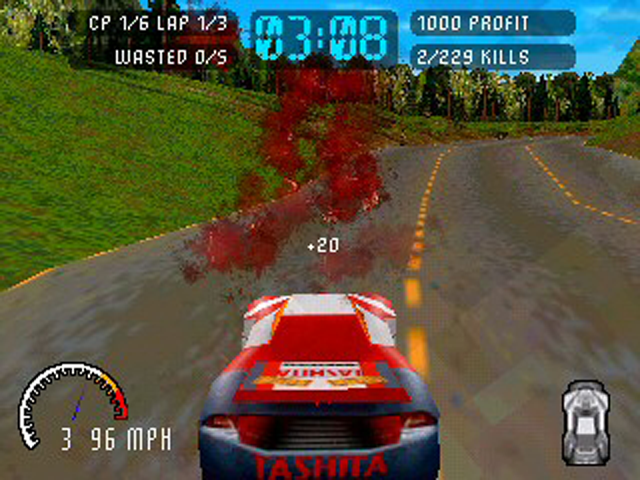
“The new car skins at higher resolution and painted in shading looked far better.” added Neil. “I also pre-lit and vertex painted all the levels, transforming them from completely flat environments to having shading baked in. As a result, everything looked way better than the original game levels. I also edited some of the events to improve the position of checkpoints and barriers etc.”
Overall, the conversion was relatively straight forward, though as with any new hardware, there were the usual challenges. “The Gizmondo had lots of memory and good CPU performance, however graphics performance was terrible.” explained Kevin. “Consequently we used memory and CPU to compensate for rendering problems. For example, to render the level we had a huge number of pre-processed models. Each model was optimised for a particular location and camera direction. I also wrote special wheel rendering code to ensure none of the back facing faces were sent to the GPU. The CPU had no floating point unit, so our physics code had to be converted to fixed point, which was a significant amount of work.”
Additionally, graphics and textures were compressed down to 64k each by being palletised to an 8-bit level to help optimisation. To assist with the polygon rendering issues, Steve also wrote a tool to apply optimisations. “We had to cut the view depth / map chunks being drawn, so I wrote a level slicer to chunk the maps up. Within the chunks the polygons were ordered by plane normal, so swathes of them could be binned if they weren’t visible from the camera. From the source, it looks like the visible map chunk list was computed for a fixed number of camera rotations. Uncompressed game data was 96MB and an average level was 5mb.”
“I do seem to also remember Nobby cutting down on the number of instances of bollards, cones etc. that were ‘shat’ out around the track (technical term).”
Sound in comparison was simply copied over from the original game and ran uncompressed, though none of the PC audio tracks were ported across. Finally, there were just minor adjustments and small improvements made, ensuring for instance that the interface and HUD were suitable for the smaller screen dimensions. “I do seem to also remember Nobby cutting down on the number of instances of bollards, cones etc. that were ‘shat’ out around the track (technical term).” remarked Ian.
The conversion was impressive, looking just like you had the PC version running in your hand. “I remember being surprised just how smoothly it ran.” reflected Ian. “I think that was mainly down to the voodoo that Kevin was doing with the physics engine. If you needed solutions to large matrices in a hurry, he was your man. The underlying engine had always been very well thought out in terms of memory management and decoupling the hardware from the game logic.”
Unfortunately, with the rush to get the game out to coincide with the launch, multiplayer functionality was dropped. A shame as the Bluetooth capabilities of the handheld could have been perfect. Other features such as camera and GPS were not used either, though Patrick revealed they had considered giving a reward for taking the device over 100mph, just to cause controversy, but this never made it into the final game.
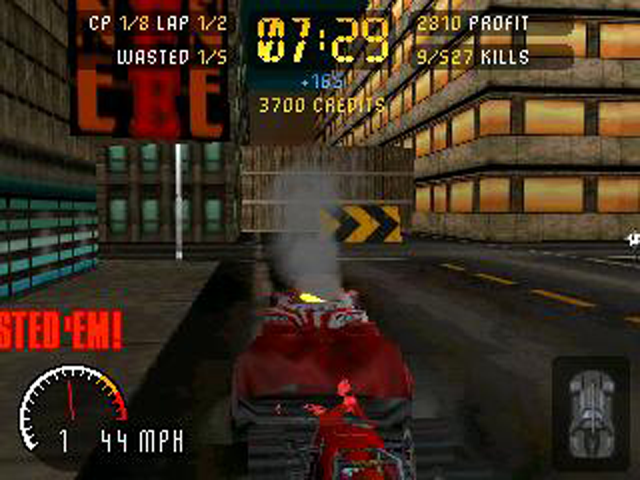
In comparison to CTV, Stainless’ conversion was unsurprisingly a far less painful affair due to being a straight conversion. Though as with CTV, the conversion would befall a similar conclusion. “It was completed just in time to see all the ‘Swedish mafia’ stuff hit the Gizmondo, and of course the infamous highway one Enzo crash[2]. So it never saw the light of day.” confirmed Patrick. “SCi were however very honourable, and their director of development, Darren Barnett paid the final milestone, even though they knew that it was never going to ship.”
With a complete Gizmondo conversion developed, could it be seen or played in the future? Well, it was confirmed to still exist by Stainless Games in all its complete source code glory. Patrick informs us that no physical versions of the final game were ever seen, including manuals or packaging. Asked whether the Gizmondo title could see release for enthusiasts of the handheld, Stainless Games politely declined, what with the game still being sold on modern platforms. A press demo has however snuck out into the wild, showcasing some of the game in action and can be easily found online, if you can find a Gizmondo to run it on that is.
“It was completed just in time to see all the ‘Swedish mafia’ stuff hit the Gizmondo, and of course the infamous highway one Enzo crash.”
In 2011, Stainless Games gained rights for the entire Carmageddon franchise, ironically including CTV, even though they never received any assets as part of the deal. The Gizmondo development was subsequently used as basis for new iOS and Android releases that have since seen over 4 million downloads to date. “The Gizmondo changes improved the visuals so much that we subsequently used the data when we came to convert the original game to mobile devices.” explained Neil. “At that stage, I edited the pedestrian data so that all of them could definitely be killed. Some level data was also edited – for instance, modifying to the curb heights in “City A” to make them consistent, so you could actually get from the road onto the pavement! We also removed rail tracks from the Mines level to make it easier to drive in.”
So after hiccups with the likes of TDR2000 and CTV, the series is now very much home with Stainless Games, with more developments planned with many of the original team members still involved. “Dr Kev Martin, the guy who basically invented video game physics with Carmageddon 1 and who joined us in ’96 is still with us.” informed Patrick. “Both artists are still here, including Neil ‘Nobby’ Barnden, who I co-founded the company with.”
With titles such as the recently released Carmageddon: Crashers, a fully re-imagined free-to-play version of Carmageddon on mobile and tablet devices, the franchise back in public consciousness once more. There is even a new top secret development coming soon, which Patrick has been carefully cryptic about. We can’t wait to see what comes next within the classic franchise and dreams of a new PC/Console release could now actually become a reality.
[1] Unfortunately, Patrick revealed that when SCi reversed into Eidos, suddenly they had much bigger fish to fry. No new Carmageddon would ever happened as a result with the newly merged publisher.
[2] The story of the Gizmondo is almost unbelievable and could even be turned into a drama/film. Certainly worth reading the timeline of events that you can find online.
